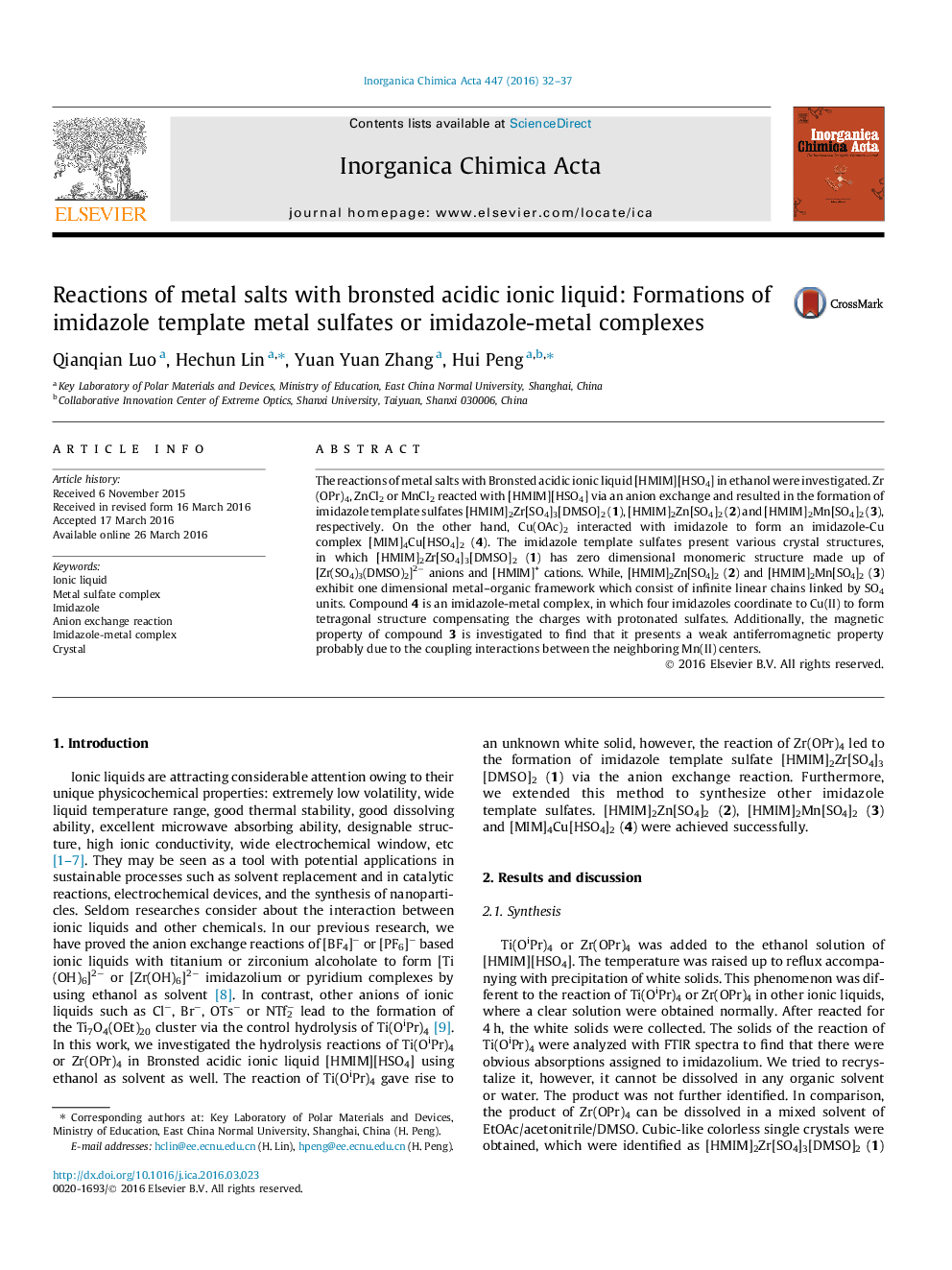| کد مقاله | کد نشریه | سال انتشار | مقاله انگلیسی | نسخه تمام متن |
|---|---|---|---|---|
| 1307475 | 1499142 | 2016 | 6 صفحه PDF | دانلود رایگان |
• Zr(OPr)4, ZnCl2 or MnCl2 reacted with [HMIM][HSO4] via anion exchange and resulted in the formation of imidazole template sulfates [HMIM]2Zr[SO4]3[DMSO]2 (1), [HMIM]2Zn[SO4]2 (2) and [HMIM]2Mn[SO4]2 (3), respectively.
• Cu(OAc)2 interacted with imidazole to form imidazole-Cu complex [MIM]4Cu[HSO4]2 (4).
• The imidazole template sulfates present various crystal structures, in which [HMIM]2Zr[SO4]3[DMSO]2 (1) has zero-dimensional monomeric structure made up of [Zr(SO4)3(DMSO)2]2− anions and [HMIM]+ cations. While, [HMIM]2Zn[SO4]2 (2) and [HMIM]2Mn[SO4]2 (3) exhibit one-dimensional metal–organic framework which consist of infinite linear chains linked by SO4 units.
The reactions of metal salts with Bronsted acidic ionic liquid [HMIM][HSO4] in ethanol were investigated. Zr(OPr)4, ZnCl2 or MnCl2 reacted with [HMIM][HSO4] via an anion exchange and resulted in the formation of imidazole template sulfates [HMIM]2Zr[SO4]3[DMSO]2 (1), [HMIM]2Zn[SO4]2 (2) and [HMIM]2Mn[SO4]2 (3), respectively. On the other hand, Cu(OAc)2 interacted with imidazole to form an imidazole-Cu complex [MIM]4Cu[HSO4]2 (4). The imidazole template sulfates present various crystal structures, in which [HMIM]2Zr[SO4]3[DMSO]2 (1) has zero dimensional monomeric structure made up of [Zr(SO4)3(DMSO)2]2− anions and [HMIM]+ cations. While, [HMIM]2Zn[SO4]2 (2) and [HMIM]2Mn[SO4]2 (3) exhibit one dimensional metal–organic framework which consist of infinite linear chains linked by SO4 units. Compound 4 is an imidazole-metal complex, in which four imidazoles coordinate to Cu(II) to form tetragonal structure compensating the charges with protonated sulfates. Additionally, the magnetic property of compound 3 is investigated to find that it presents a weak antiferromagnetic property probably due to the coupling interactions between the neighboring Mn(II) centers.
Zr(OPr)4, ZnCl2 or MnCl2 reacted with [HMIM][HSO4] via anion exchange and resulted in the formation of imidazole template sulfates [HMIM]2Zr[SO4]3[DMSO]2 (1), [HMIM]2Zn[SO4]2 (2) and [HMIM]2Mn[SO4]2 (3), respectively. On the other hand, Cu(OAc)2 interacted with imidazole to form imidazole-Cu complex [MIM]4Cu[HSO4]2 (4). The imidazole template sulfates present various crystal structures, in which [HMIM]2Zr[SO4]3[DMSO]2 (1) has zero-dimensional monomeric structure made up of [Zr(SO4)3(DMSO)2]2− anions and [HMIM]+ cations. While, [HMIM]2Zn[SO4]2 (2) and [HMIM]2Mn[SO4]2 (3) exhibit one-dimensional metal–organic framework which consist of infinite linear chains linked by SO4 units. Compound 4 is an imidazole-metal complex, in which four imidazoles coordinate to Cu(II) to form tetragonal structure compensating the charge with protonated sulfate.Figure optionsDownload as PowerPoint slide
Journal: Inorganica Chimica Acta - Volume 447, 1 June 2016, Pages 32–37
